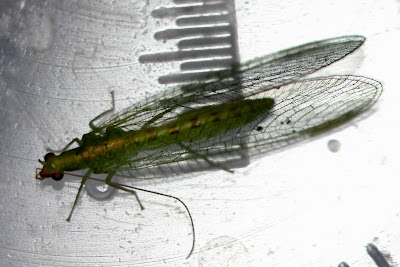We travelled back up the River Soar and moored at Millers Bridge near Pillings Lock Marina. It's a lovely spot that we've stayed at loads of times in the past. We had a couple of visitors, one of which was only my second moth of the trip, another Micro moth, a Garden Rose Tortrix (Acleris variegana). A bit ironic that our travels around the countryside only turned up 2 moths...a house moth & a garden moth!
 |
| Garden Rose Tortrix |
I rememeber years ago being on a birding trip in Norfolk when I popped into a tiny village Post Office and overhead the Postmistress & another customer discussing the identification of Micro moths. I came out chuckling about sad people in anoraks... .
Our second visitor was a Green Lacewing of which there are between 14 &18 species in the UK depending on which website you look at. Lacewings live for about 10 months & are good for the garden as they eat aphids. They readily go into houses, & apparently boats, in the Autumn. As usual there are a lot of similar species but I think this one is the Com
mon Green Lacewing (Chrysoperla carnea) as it had dull pink patches on the body & this species turns pink in the Autumn for hibernation.
We moved down the canal a short distance & moored outside the marina for a spot of polishing. Whislt taking a short break I spotted a dragonfly land in a bush next to Muriel. It was a Migrant Hawker & it stayed there for about half an hour sunbathing.
 |
| Migrant Hawker (mature male) |
A Red Admiral (Vanessa atalanta)came to feed on the same bush & also stayed for a while.
 |
| Red Admiral |
We're now back in Exmouth for the winter where I'll be doing lots of birding & wildlife spotting! I may even decide to start a blog..........




















































